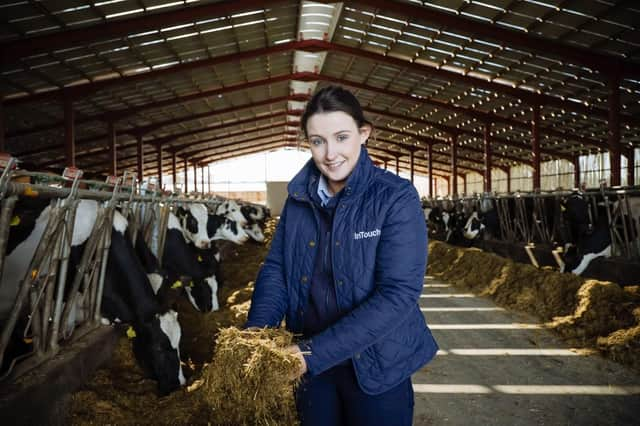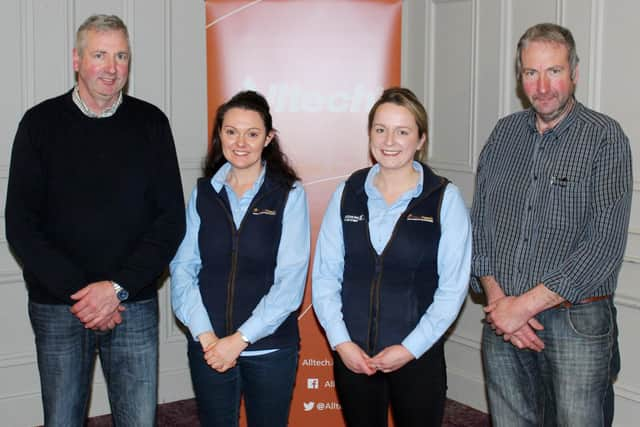Climate change is boosting the threat of mycotoxins


They cannot be seen with the naked eye, and they cannot be tasted — but they are toxic.
More than 500 different mycotoxins have been identified to date, and most animal feedstuffs are likely to be contaminated to some degree, including grazed grass, conserved forages (silage, wholecrop, maize, straw) plus home-grown and bought-in concentrate feeds.
Advertisement
Advertisement
One example of a harmful mycotoxin is penicillic acid, which, according to silage specialist Dr Dave Davies, is now one of the most common forms of mycotoxins produced in Irish grass silages.


Dr Davies attributes the increased threat posed by this and many other mycotoxins today, at least in part, to the impacts of climate change, adding that the issue of mycotoxins would not even have been on his radar a decade ago.
“But today,” he added, “we find that the threat of both in-field and in-store mycotoxins represents a major challenge for farmers and the entire feed industry.
"Management decisions taken by farmers while crops are growing and being harvested will have a major impact on the development or otherwise of in-store mycotoxins subsequent to harvest.”
Advertisement
Advertisement
Davies spoke at a recent mycotoxins’ workshop, hosted by Alltech.
The event was attended by farmers and feed industry representatives from across Northern Ireland.
He went on to say that silage that is free of mould is not necessarily free of mycotoxins.
Fungal attack in the field can led to the production of mycotoxins at that stage, which are subsequently brought into the silo.
Advertisement
Advertisement
Conversely, silages containing moulds may not contain mycotoxins.
Dr Davies gave the example of Tipperary blue cheese, which is inoculated with a microorganism that does not generate mycotoxins.
“This is a complex story, one which we are learning about as scientists,” he said.
He went on to point out that mycotoxins are secondary metabolites, produced by moulds, but not yeasts.
Advertisement
Advertisement
Moreover, they are toxic at very low concentrations and are hard to denature in a physical sense.
For example, mycotoxins are very resistant to both chemical attack and the impact of heat.
Dr Davies attributed the onset of milder winters as being a core reason behind the growth in the threat posed by mycotoxins.
“As a consequence, there is a lower kill-off of the moulds and yeasts that live in the decaying material found at the bottom of all grass swards,” he said.
Advertisement
Advertisement
“Extremes of temperature and the increased threat of drought throughout the growing season are creating the conditions that facilitate the growth of Penicillium fungi in all feedstuffs.
“So the reality is that much lower levels of fungi are being killed in the field.”
Davies continued:
“Yeasts, on the other hand, do not produce mycotoxins.
" However, they do initiate aerobic spoilage within forages.
"The onset of aerobic conditions will facilitate the growth of moulds that produce in-store mycotoxins.”
Advertisement
Advertisement
The forage specialist outlined several steps that can be taken, both in the field and while ensiling a clamp, to minimise the threat of mould growth and subsequent mycotoxin production.
The key driver in-field is to secure the required level of wilting as quickly as possible while minimising soil contamination of the subsequent silage, which is a key source of both fungal and clostridial inoculation.
Dr Davies recommended a grass cutting height of 10cm, explaining:
“This provides the cut grass with a cushion of stubble to lie on, which facilitates the circulation of air around it.
Advertisement
Advertisement
“Cut grass should also be kicked out as quickly as possible, again to hasten the wilting process.
"Cutting to 10cm also encourages subsequent sward re-growth.”
He continued:
“It is also important to ensure that all cut grass is lifted.
"Forage that is left in the field will start to decay, thereby representing a possible fungal source for second-cut crops.”
Advertisement
Advertisement
Where the ensiling process is concerned, Dr Davies recommends the use of side sheets, an oxygen barrier film and a top cover.
Tyres and/or gravel will further aid this process.
In this way, it is possible to secure an extremely effective seal along the top and sides of the silage clamp. In addition, grass should be consolidated in 15-cm layers.
“Providing totally anaerobic conditions within the silo is critical,” Dr Davies explained.
“The introduction of air, no matter in how small a quantity, will encourage the growth of moulds and yeasts.”
Advertisement
Advertisement
Limiting the amount of time that forage is exposed to oxygen at feed-out reduces the chance of mycotoxin development as well.
According to Dave Davies, silage covers should only be removed at point of feeding, with the aim to move across the face as quickly as possible and, if needed, to take half blocks.
“A sharp shear grab or block cutter should be used to keep the face as clean and even as possible.”
The scope of the mycotoxin challenge in 2023
Meanwhile, the scale of the mycotoxin challenge in local silages is higher than in previous years and will need to be managed in order to maintain performance.
Advertisement
Advertisement
This was the key assertion made by Alltech’s Aislínn Campbell in her presentation to a recent mycotoxins’ workshop.
Alltech’s European Harvest Analysis Programme for 2023 has highlighted testing results from grass silage, straw and TMR samples, taken throughout Ireland over recent weeks.
All of the work was carried out at the Alltech 37+® laboratory, based at Dunboyne in Co. Meath.
The facility provides a comprehensive overview of the mycotoxin risk in animal feeds by testing for 54 individual mycotoxins.
Advertisement
Advertisement
The results this year confirmed that 63% of grass silage samples, 15% of straw samples, and 76% of TMR samples were at high risk for mycotoxins.
To better understand the link between mycotoxins and animal performance, Alltech’s mycotoxin management team has developed the risk equivalent quantity (REQ).
This figure represents the overall mycotoxin risk associated with a sample and a particular species’ health and performance, based on the cumulative effect of the groups of mycotoxins present in a feed sample.
“Of the Irish grass silages assessed, 62.9% posed a high mycotoxin risk, 5.7% a moderate risk, and 31.4% a low risk,” Aislínn explained.
Advertisement
Advertisement
“Penicillium compounds represented the highest mycotoxin grouping identified.
"The average REQ value measured across all the samples analysed was 322.8.
“These numbers represent a worst-case scenario when considering a cumulative effect of various mycotoxins.”
So what could all this mean for dairy cow performance?
According to Campbell, an REQ figure of 323 could impair milk production by up to 0.74L/cow/day while increasing cell count by a factor of 107.2%.
Advertisement
Advertisement
She added: “Where 2023 straw analyses are concerned, 14.3%of samples posed a high mycotoxin risk, 14.3% a moderate risk, and 71.4% a low risk.
The average straw REQ value was 286.
“Straw included within a TMR with an REQ value of 286 could have a negative on somatic cell count.
“However, when included in a TMR, it is important to consider the effects of straw in relation to mycotoxin risk, something that is often overlooked.”
Mycotoxins and animal health
The global director of Alltech’s mycotoxin management team, Nick Adams, also spoke at the workshop.
Advertisement
Advertisement
He confirmed that mycotoxins can affect any animal at any stage of production.
Problems can be ongoing or flare up suddenly, even on the same pit of silage. This may be due to hitting pockets of mycotoxins in the clamp.
Animals may exhibit one symptom or several.
Mycotoxins can reduce appetite, gut integrity and rumen function, decreasing the animal’s ability to absorb nutrients from feed, resulting in performance losses.
Symptoms may include reduced or fluctuating milk yield, poor milk solids or reduced daily live weight gain (DLWG).
Advertisement
Advertisement
Fluctuating forage intakes, variable dung consistency across a batch of animals, or loose dung consistency can also be signs of gut problems.
Mycotoxins suppress the immune system, a problem which can manifest itself in multiple ways, including cell count problems such as raised somatic cell count (SCC), often leading to increased cases of mastitis or E. coli, swollen hocks, lameness and rough coats.
Fertility problems caused by mycotoxins can range from irregular heats to cysts, lower conception rates and abortions.
Getting to grips with the mycotoxin challenge
Mycosorb is a binder based on a specific strain of yeast.
It is a broad-spectrum agent that tackles mycotoxin populations rather than dealing with individual mycotoxins.
Advertisement
Advertisement
As it is a yeast-based binder, it will impact more efficiently on a greater range of mycotoxins, reducing their absorption without reducing the necessary absorption of essential — and expensive — vitamins and minerals.
When considering adding a mycotoxin binder to your feed, keep in mind that Mycosorb offers the following:
- Proven by independent research
- A low effective inclusion rate
- Stable over a wide pH, so that the mycotoxin stays attached to the binder throughout the gut and is then excreted
- Ability to absorb a high capacity and broad spectrum of mycotoxins
- Ability to react rapidly within the animal
In conclusion
Advertisement
Advertisement
The 2023 silage season has been one of extremes, with the weather playing a critical role.
The early weeks of May were characterised by intermittent and heavy showers, with June delivering almost heat-wave conditions.
But as midsummer beckoned, the clouds opened, with July registering the highest level of midsummer rainfall ever recorded — and the changeable weather patterns have been maintained right up to now.
Many scientists had predicted that the nature of the 2023 growing season would predispose grass silages and straw to heavy mycotoxin contamination. And the results of the Alltech 2023 Harvest Analysis have proven that they were correct.
Advertisement
Advertisement
The inclusion of an effective binder will help redress the challenge posed by mycotoxins during the 2023–24 feeding season.
However, it is incumbent on farmers to reduce the impact of mycotoxins within their forages in the first place.
There is no doubt that the very changeable weather patterns of 2023 have affected silage quality from several perspectives.
Yes, farmers are very aware that cutting date is the critical factor in determining forage quality.
Advertisement
Advertisement
But in many cases, continuous rain and poor ground conditions prevented contractors and farmers from physically getting out into fields to harvest grass at the most appropriate times.
There were also numerous cases of farmers not being able to get operators on site when required. This was a direct result of contractors being so busy during those short breaks in the weather when it did prove possible to get grass cut, picked up and ensiled.
Many aspects of silage quality are outside the farmers’ direct control. When it comes to managing the threat posed by mycotoxins, the first step in the process is that of farmers being aware that the problem exists in the first place.
Alltech is an American company, headquartered in Nicholasville, Kentucky, with operations in animal feed, meat, brewing, and distilling.